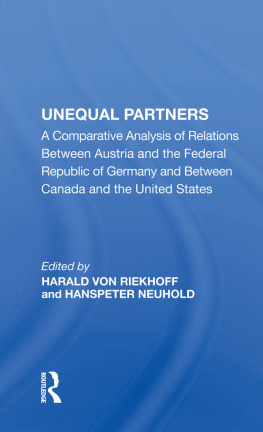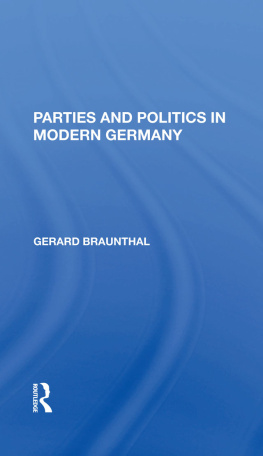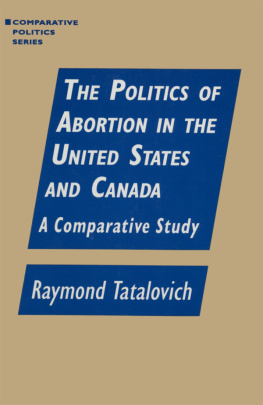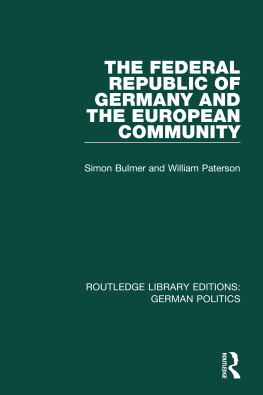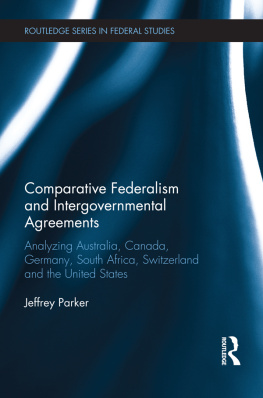UNEQUAL PARTNERS
AUSTRIAN INSTITUTE FOR INTERNATIONAL AFFAIRS SERIES
The Austrian Institute for International Affairs (AIIA) is an independent research institution for the scientific study of current issues of Austrian foreign policy and international relations.
The Vienna Meeting of the Conference on Security and Cooperation in Europe, 1986-1989: A Turning Point in East-West Relations, Stefan Lehne
The European Neutrals in the 1990s: New Challenges and Opportunities, edited by Hanspeter Neuhold
Unequal Partners: A Comparative Analysis of Relations Between Austria and the Federal Republic of Germnany and Between Canada and the United States, edited by Harald von Riekhoff and Hanspeter Neuhold
UNEQUAL PARTNERS
A Comparative Analysis of Relations Between Austria and the Federal Republic of Germany and Between Canada and the United States
edited by HARALD VON RIEKHOFF and HANSPETER NEUHOLD
First published 1993 by Westview Press, Inc.
Published 2019 by Routledge
52 Vanderbilt Avenue, New York, NY 10017
2 Park Square, Milton Park, Abingdon, Oxon OX14 4RN
Routledge is an imprint of the Taylor & Francis Group, an informa business
Copyright 1993 Taylor & Francis
All rights reserved. No part of this book may be reprinted or reproduced or utilised in any form or by any electronic, mechanical, or other means, now known or hereafter invented, including photocopying and recording, or in any information storage or retrieval system, without permission in writing from the publishers.
Notice:
Product or corporate names may be trademarks or registered trademarks, and are used only for identification and explanation without intent to infringe.
A CIP catalog record for this book is available from the Library of Congress.
ISBN 13:978-0-813-38314-9 (hbk)
Contents
Part One
Overview
Harald von Riekhoff
Henry J. Jacek
Part Two
Historical Relations
Frederick C. Engelmann
Gnter Bischof
Joseph Levitt
Part Three
Political Relations
Hanspeter Neuhold
David Leyton-Brown
Part Four
Economic Relations
Georg Winckler
D. Mark Schultz
Bruce W. Wilkinson
Part Five
Cultural and Media Relations
Adolf Haslinger
Stanley Fogel
Hans Heinz Fabris
Frederick J. Fletcher and Martha Fletcher
Guide
The theoretical core of this book has been the focus of a Carleton University research project on the foreign policy in asymmetrical dyads. The theory had been tested with reference to Canadian-U.S. relations, but the chapters presented in this book broaden the empirical basis by focusing on two such unequal partnerships, Austria and the Federal Republic of Germany, on the one hand, and Canada and the United States, on the other, and by distinguishing between different dimensions, notably the historical, political, economic, cultural, and media aspects of the relationships. The combination of a comparative approach with a multidimensional treatment transcends the standard literature on inequality in international relations, which is generally confined to a single dyad and rarely encompasses more than the political or economic aspects of that relationship.
This study has deliberately created its own, albeit reversed, asymmetry, as it is written from the perspective of the subordinate rather than the dominant actors. It thereby tries to redress, even if only in a small way, the customary neglect of the smaller states at the expense of a natural preoccupation with the policies of the major international actors like the United States and the Federal Republic of Germany.
We are greatly Indebted to Dr. Elisabeth Mach, Cultural and Press Affairs Counselor at the Austrian Embassy in Ottawa, Dr. Elke Schmitz, Cultural Counsellor at the Embassy of the Federal Republic of Germany in Ottawa, and to Professor Frederick Engelmann of the University of Alberta, who provided valuable assistance and encouragement throughout the long planning process for the symposium in Ottawa where the chapters appearing in this volume were originally presented as conference papers. Brenda Sutherland typed the manuscript with customary vigor and exemplary cheerfulness, and Susanna Mai completed the volume at the Austrian Institute for International Affairs. We are also indebted to Westview Press for including the book in the Austrian Institute for International Affairs Series and for their editing assistance. We are grateful for the financial assistance that was provided by the Austrian Foreign Ministry, the Canadian Department of External Affairs, and the Social Sciences and Humanities Research Council of Canada.
Harald von Riekhoff
Hanspeter Neuhold
PART ONE
Overview
1
Introduction: Toward a Comparison of Relations Between Austria/FRG and Canada/United States
Harald von Riekhoff
Bilateral relations between Austria and the Federal Republic of Germany (FRG) and between Canada and the United States can be examined from the more general perspective of relations between unequal partners. An unequal partnership denotes relations between countries that have a common or closely related language, relatively homogeneous cultures, geographic proximity, a high level of transactions, and a significant inequality of power. Charles Doran views partnerships of this type as "an alternative to either integration or autarky," under conditions in which autarky is impossible because of the high degree of interdependence and integration is unacceptable, at least for the smaller partner, for one reason or another. It should be noted that the term "smaller" is used in the sense of "less powerful" throughout this volume; it is applied to Canada, for example, in relation to the United States, although in terms of geographic size Canada is bigger than the United States.
Charles F. Doran, Forgotten Partnership: U.S.-Canadian Relations Today, Toronto (1984), p. 260.
A number of other countries would fit this definition of unequal partnership in addition to the four selected for this study, as for example Ireland and Great Britain, New Zealand and Australia (although proximity here is relative in the absence of other immediate neighbors), Norway and Sweden, and Portugal and Spain. Perhaps one might also add Switzerland and the FRG, although the common language, as is also true for Canada, does not encompass the entire population of the smaller partner.
The chapters in this study single out, in the following order, four distinct dimensions that affect relations between unequal partners: historical, political, economic, and cultural. For organizational purposes media relations have been treated as part of the section devoted to culture, although they are equally relevant to the political economy of the two partnerships. From the perspective of the subordinate country, which is the one taken here, the relationship with the superordinate partner is characterized by an underlying tension between socioeconomic forces (which normally work toward increased integration with the major partner) and political- and in the Austrian case legal - considerations (which work toward preservation of the autonomy and distinctiveness of the smaller actor). The historical dimension allows observation of the unfolding of this dialectical process through time. The impact of the cultural dimension appears to be essentially ambivalent. On the one hand, cultural homogeneity would tend to facilitate integration, while on the other hand culture shapes a distinct national identity and thereby helps the subordinate actor in maintaining its commitment to political autonomy in the face of economic counterpressures.

